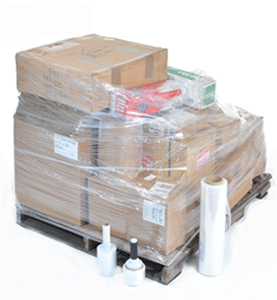 A pallet is a platform that is used to transport a huge and heavy package or several smaller boxes safely and with ease. Pallets come in a variety of sizes and can be made from different materials including wood, metal and plastic. Pallets make it easier to move bulky and heavy packages with the use of machinery like forklifts or pallet jacks, making the transport of these items more safe and less cumbersome.
A pallet is a platform that is used to transport a huge and heavy package or several smaller boxes safely and with ease. Pallets come in a variety of sizes and can be made from different materials including wood, metal and plastic. Pallets make it easier to move bulky and heavy packages with the use of machinery like forklifts or pallet jacks, making the transport of these items more safe and less cumbersome.
However, proper packing precautions must be observed when shipping in pallets. Improper stacking of packages and failing to secure and strap the boxes on the pallet could spell accidents, injury to the handlers and damages to the items. Here are some shipping tips on how to properly pack a pallet.
Whether shipping one humongous package or many boxes, make sure that every package have sufficient packing materials and cushion to prevent the items inside from moving or shifting. For one big package, use a pallet that can support its entire weight and keep it stable when resting on the ground. Wrapping one big package in plastic wrap is optional but doing so will protect the package from the elements such as moisture and dirt. Strapping it on the pallet is a must.
When transporting multiple boxes, place the bigger and heavier boxes first on the the floor of the pallet before stacking the smaller and lighter packages on top. Also make sure that the bottom boxes cover the floor of the entire pallet to provide a stable base. Only use sturdy boxes that can withstand and support the weight of the packages on top, otherwise, the boxes at the bottom of the pile could get crushed.
Stack the boxes in such a way that each layer’s top is even so that the packages that will be placed on top will have a stable environment. Each box should also be as close to each other as possible to eliminate any space that could cause movement or shifting. Continue stacking until all packages are in place. Keep in mind that the pallet should only be packed chest high. Stacking higher than that could increase the chances of the boxes shifting or toppling down. Handling pallets that are packed above chest height could also spell accidents and injuries to the shipping personnel.
Pull about a yard of stretch plastic and bunch into a rope-like form. Thread it around one of the pallet corners then start wrapping the bottom packages to create a solid base. Wrap the plastic film around the base as tight as possible for not less than five times.
Then, start working your way up the entire stack, making sure that the plastic film is pulled tightly in every turn. Remember that the tighter the wrap, the more firmly it will hold. The stack of packages should end up into one solidly packed unit, without any wobbling or movement. Wrap the entire pallet in several layer of plastic wrap. Cut the plastic film and tuck the end on a fold to hold it in place.
Secure the plastic wrapped packages by strapping it into the pallet. Packing straps come in a variety of materials including metal and plastics like polypropylene, polyester and nylon. Plastic staps are usually fastened by using a tool the fuses the two ends with heat.
